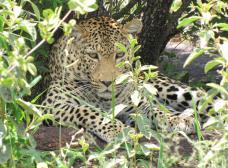Hunting sector to head up leopard research
The project, headed up by TUT’s big predator behavior specialist, Dr Nkabeng Maruping-Mzileni, is the brainchild of the Limpopo Hunters Liaison Forum (LHLF). They are channeling it through the Professional Hunters’ Association of South Africa’s (PHASA) Conservation Research Fund (CRF), which forms part of PHASA’s Hunters Care initiative.
Phillip Bronkhorst, PHASA member and chairman of the LHLF explains: “For non-detrimental findings to accurately reflect the true status of leopards in South Africa, more scientific data on their habitat requirements, distribution and population numbers are required.”
This is where the hunting and safari sector, together with TUT, can play an integral role: Over the years, the LHLF’s web-based data programme, Catspotter, has proven to be a successful data capturing tool.
The LHLF made some improvements to the above to accommodate and meet the South African Biodiversity Institute’s (SANBI) data collection requirements: For scientific data to be considered for inclusion in non-detrimental findings, SANBI stipulates that all video footage or photographic images should clearly identify, illustrate and confirm the presence of free-roaming leopards in the area (e.g. spoor, leopard hair on prey etc.), and have the correct date and GPS coordinates on it.
“It is easy to upload photos or videos onto www.catspotter.co.za. And don’t despair if you don’t have a camera that indicates dates and times or GPS coordinates, we have a drag and drop tool that you can use to assign the exact location of the sighting and/or add the relevant dates and times,” says Bronkhorst.
Anything from trail cam photos to simple cell or smart phone images can be uploaded as long as it meets SANBI’s criteria above.
“The fact that citizen science can be included in our research makes the project unique, thorough, all-inclusive and exciting as any member of the public with the relevant scientific data to their disposal can contribute,” says Dr Maruping-Mzileni.
Bronkhorst adds that members of the safari and hunting community are ideally positioned to collect valuable scientific data on the above as they regularly interact with the predators included in the project.
The trail cams, baiting stations (used for data capturing purposes) and the wild game or domestic animals that leopard prey on and kill attract a wide range of the following smaller to medium sized predators that will be included in the research as well:
- African Wild Cat
- Civet Cat
- Cheetah
- African Wild Dog (Cape Hunting Dog)
- Caracal
- Serval Cat
- Honey Badger
- Brown Hyena
- Spotted Hyena
- Wild Roaming Lion
- Genet cat
PRIVATE FUNDING
Being an ongoing private sector research initiative, funding is essential.
“We need to raise approximately R 1.5-million to see the project through the first year, and will be approaching our partners in the hunting, safari and other sustainable use sectors, amongst others, to raise the above,” says Bronkhorst.
While associated costs are expected to decrease as the project moves along, “it will take a minimum of three years to collect the scientific data required,” adds Dr Maruping-Mzileni.
*Contributions made to the project through PHASA’s Conservation Research Fund are tax deductible.













0 Comments